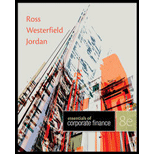
Concept explainers
Financing S&S Air’s Expansion Plans with a Bond Issue
Mark Sexton and Todd Story, the owners of S&S Air, have decided to expand their operations. They instructed their newly hired financial analyst, Chris Guthrie, to enlist an underwriter to help sell $20 million in new 10-year bonds to finance construction. Chris has entered into discussions with Renata Harper, an underwriter from the firm of Crowe & Mallard, about which bond features S&S Air should consider and what coupon rate the issue will likely have.
Although Chris is aware of the bond features, he is uncertain as to the costs and benefits of some features, so he isn’t clear on how each feature would affect the coupon rate of the bond issue. You are Renata’s assistant, and she has asked you to prepare a memo to Chris describing the effect of each of the following bond features on the coupon rate of the bond. She would also like you to list any advantages or disadvantages of each feature.
3. The presence of a sinking fund.
Want to see the full answer?
Check out a sample textbook solution
Chapter 6 Solutions
Essentials of Corporate Finance
- How are HRISs changing how companies manage their compensation and benefit plans?arrow_forward3. A bond's yield to maturity (YTM) is:A. The coupon rateB. The rate of return required by investorsC. The market price of the bondD. The par value of the bondarrow_forwardNeed help The time value of money concept suggests:A. A dollar today is worth less than a dollar tomorrowB. Money loses value over time due to inflationC. A dollar today is worth more than a dollar in the futureD. Interest has no effect on present valuearrow_forward
- The time value of money concept suggests:A. A dollar today is worth less than a dollar tomorrowB. Money loses value over time due to inflationC. A dollar today is worth more than a dollar in the futureD. Interest has no effect on present valuearrow_forward(Related to Checkpoint 17.1) (Forecasting discretionary financing needs) Huang Electronics, Inc., operates a chain of electrical lighting and fixture distribution centers throughout northern Arizona. The firm is anticipating expansion of its sales in the coming year as a result of recent population growth trends. The firm's financial analyst has prepared pro forma balance sheets that reflect three different rates of growth in firm sales for the coming year and the corresponding non-discretionary sources of financing the firm expects to have available, as follows: a. What are the firm's discretionary financing needs under each of the three growth scenarios? b. What potential sources of financing are there for Huang Electronics to fulfill its needs for discretionary financing? a. The discretionary financing needs for a 10% growth scenario are $ (Round to the nearest dollar.)arrow_forward(Related to Checkpoint 17.1) (Forecasting discretionary financing needs) In the spring of 2023, the Caswell Publishing Company established a custom publishing business for its business clients. These clients consisted principally of small- to medium-size companies in Round Rock, Texas. However, the company's plans were disrupted when it landed a large printing contract which it expects will run for several years. Specifically, the new contract will increase firm revenues by 100 percent. Consequently, Caswell's managers know they will need to make some significant changes in firm capacity, and quickly. The following balance sheet for 2023 and pro forma balance sheet for 2024 reflect the firm's estimates of the financial impact of the 100 percent revenue growth: a. How much new discretionary financing will Caswell require based on the above estimates? b. Given the nature of the new contract and the specific needs for financing that the firm expects, what recommendations might you offer…arrow_forward
- (Related to Checkpoint 17.1) (Forecasting discretionary financing needs) Bates Fabricators, Inc. estimates that it invests 25 cents in assets for each dollar of new sales. However, 4 cents in profits are produced by each dollar of additional sales, of which 1 cent(s) can be reinvested in the firm. If sales rise by $773,000 next year from their current level of $5.36 million, and the ratio of spontaneous liabilities to sales is 0.17, what will be the firm's need for discretionary financing? (Hint: In this situation, you do not know what the firm's existing level of assets is, nor do you know how those assets have been financed. Thus, you must estimate the change in financing needs and match this change with the expected changes in spontaneous liabilities, retained earnings, and other sources of discretionary financing.) The discretionary financing needs will be $ (Round to the nearest dollar.)arrow_forwardI mistakenly submitted blurr image please comment i will write values. please dont Solve with incorrect values otherwise unhelpful.need helparrow_forwardHello expert see carefully I mistakenly submitted blurr image please comment i will write values. please dont Solve with incorrect values otherwise unhelpful.arrow_forward
- I mistakenly submitted blurr image please comment i will write values. please dont Solve with incorrect values otherwise unhelpful. helloarrow_forwardI mistakenly submitted blurr image please comment i will write values. please dont Solve with incorrect values otherwise unhelpful. hiarrow_forwardHello tutor i need help I mistakenly submitted blurr image please comment i will write values. please dont Solve with incorrect values otherwise unhelpful.arrow_forward
 Cornerstones of Financial AccountingAccountingISBN:9781337690881Author:Jay Rich, Jeff JonesPublisher:Cengage Learning
Cornerstones of Financial AccountingAccountingISBN:9781337690881Author:Jay Rich, Jeff JonesPublisher:Cengage Learning Intermediate Accounting: Reporting And AnalysisAccountingISBN:9781337788281Author:James M. Wahlen, Jefferson P. Jones, Donald PagachPublisher:Cengage Learning
Intermediate Accounting: Reporting And AnalysisAccountingISBN:9781337788281Author:James M. Wahlen, Jefferson P. Jones, Donald PagachPublisher:Cengage Learning EBK CONTEMPORARY FINANCIAL MANAGEMENTFinanceISBN:9781337514835Author:MOYERPublisher:CENGAGE LEARNING - CONSIGNMENT
EBK CONTEMPORARY FINANCIAL MANAGEMENTFinanceISBN:9781337514835Author:MOYERPublisher:CENGAGE LEARNING - CONSIGNMENT




